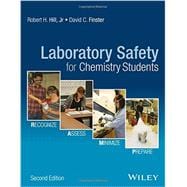- Aligns with the revised safety instruction requirements from the ACS Committee on Professional Training 2015 “Guidelines and Evaluation Procedures for Bachelor’s Degree Programs”
- Provides a systematic approach to incorporating safety and health into the chemistry curriculum
- Topics are divided into layers of progressively more advanced and appropriate safety issues so that some topics are covered 2-3 times, at increasing levels of depth
- Develops a strong safety ethic by continuous reinforcement of safety; to recognize, assess, and manage laboratory hazards; and to plan for response to laboratory emergencies
- Covers a thorough exposure to chemical health and safety so that students will have the proper education and training when they enter the workforce or graduate school








